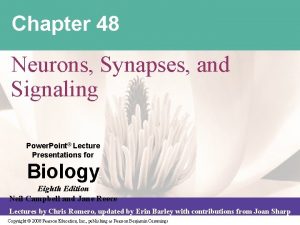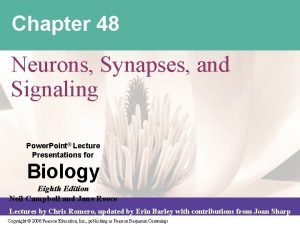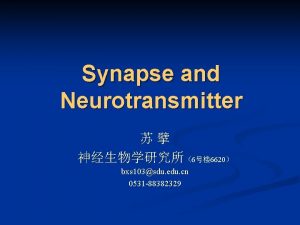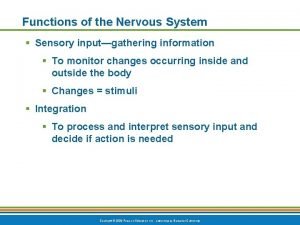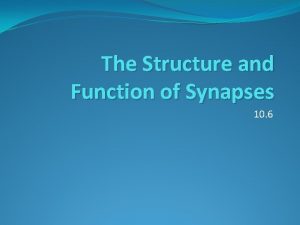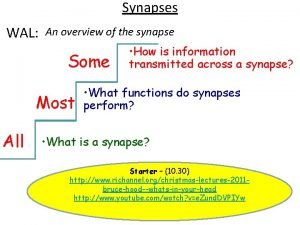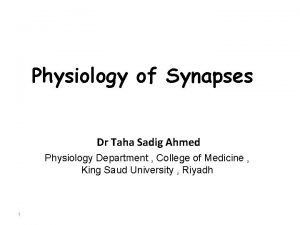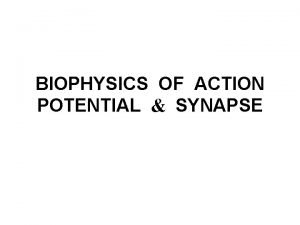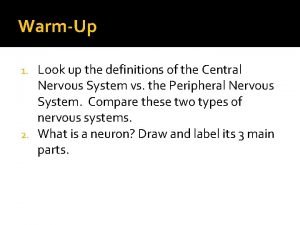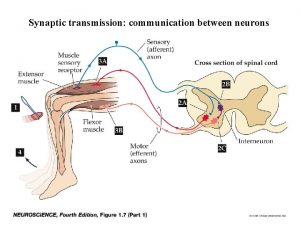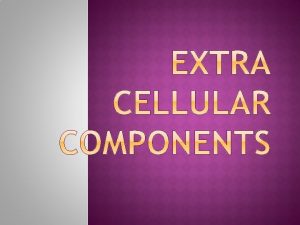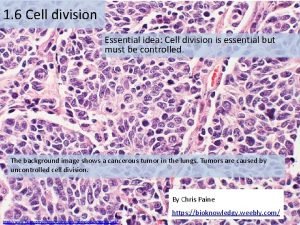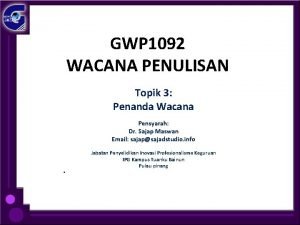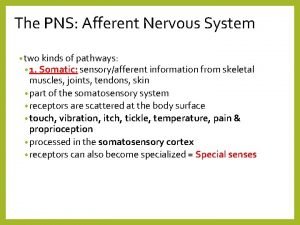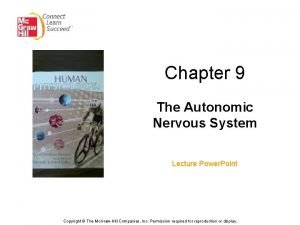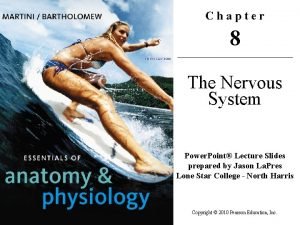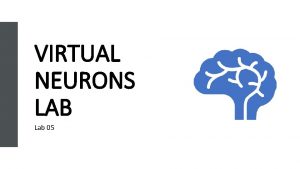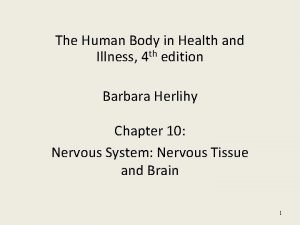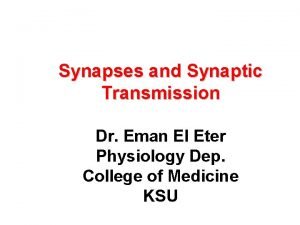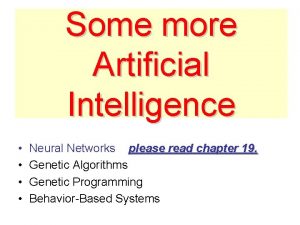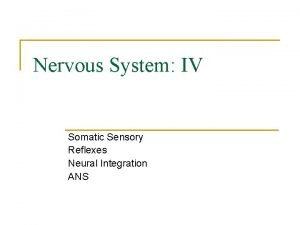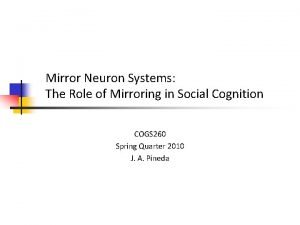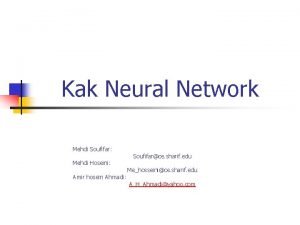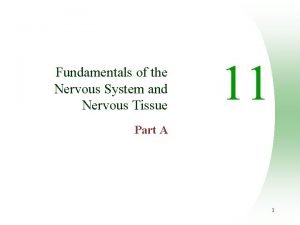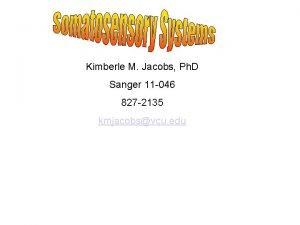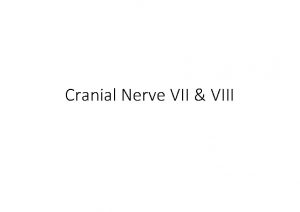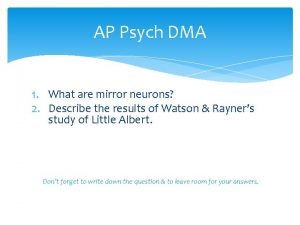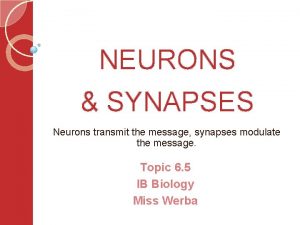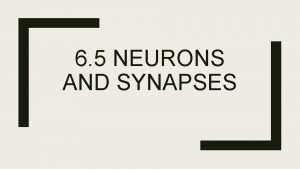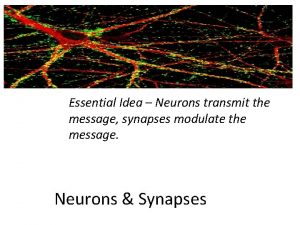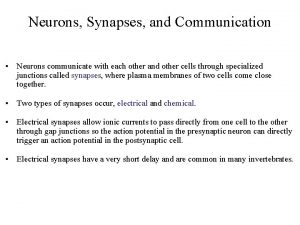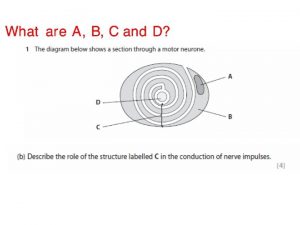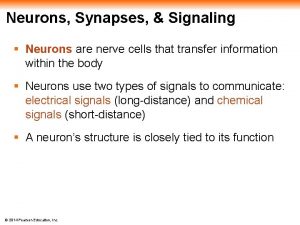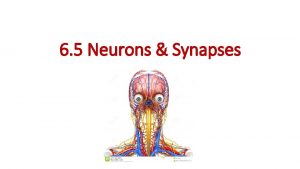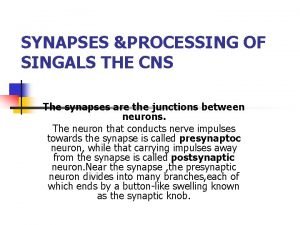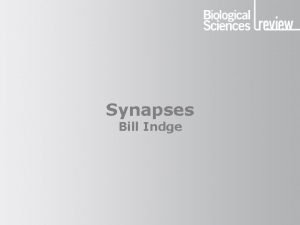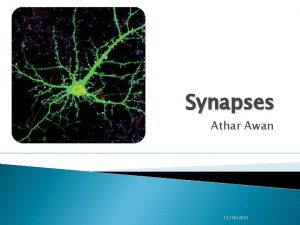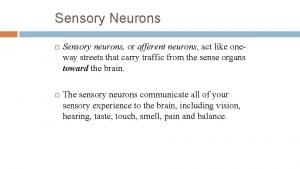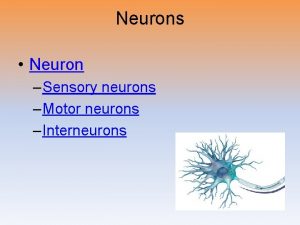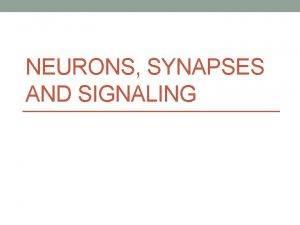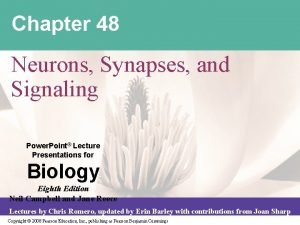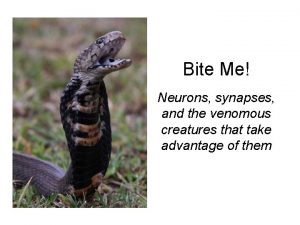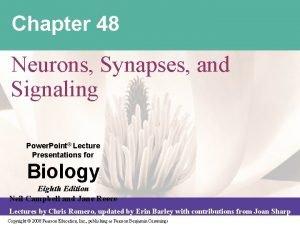6 5 Neurons and synapses Essential idea Neurons







































- Slides: 39

6. 5 Neurons and synapses Essential idea: Neurons transmit the message, synapses modulate the message.

Understandings Statement 6. 5 U. 1 Neurons transmit electrical impulses. 6. 5 U. 2 The myelination of nerve fibers allows for saltatory conduction. 6. 5 U. 3 Neurons pump sodium and potassium ions across their membranes to generate a resting potential. 6. 5 U. 4 An action potential consists of depolarization and repolarization of the neuron. 6. 5 U. 5 Nerve impulses are action potentials propagated along the axons of neurons. 6. 5 U. 6 Propagation of nerve impulses is the result of local currents that cause each successive part of the axon to reach the threshold potential. 6. 5 U. 7 Synapses are junctions between neurons and receptor or effector cells. 6. 5 U. 8 When presynaptic neurons are depolarized they release a neurotransmitter into the synapse. 6. 5 U. 9 A nerve impulse is only initiated if the threshold potential is reached. Guidance The details of structure of different types of neuron are not needed. Only chemical synapses are required, not electrical, and they can simply be referred to as synapses.

Applications and Skills Statement Guidance Secretion and reabsorption of acetylcholine by neurons 6. 5 A. 1 at synapses. 6. 5 A. 2 Blocking of synaptic transmission at cholinergic synapses in insects by binding of neonicotinoid pesticides to acetylcholine receptors. 6. 5 S. 1 Analysis of oscilloscope traces showing resting potentials and action potentials.

Types of Neurons • • • Sensory neurons: info from body sensors spine and brain (central nervous system (CNS)) Interneurons: connect sensory + motor neurons (peripheral nervous system (PNS)), or local connections between brain + spinal cord (CNS) Motor neurons: CNS body (effectors = muscles, glands)

Sensory neurons Interneurons Motor neurons

6. 5 U. 1 Neurons transmit electrical impulses. Nerve cells • Nerve cell (neuron) signal direction • Structure fits function dendrites cell body axon – many entry points for signal in – one path out – transmits signal direction myelin sheath dendrite cell body axon synaptic terminal synapse

6. 5 U. 1 Neurons transmit electrical impulses. Transmission of a signal from nerve cell to nerve cell Think dominoes! – start the signal • knock down line of dominoes by tipping 1 st one trigger the signal – propagate the signal • do dominoes move down the line? no, just a wave through them! – re-set the system • before you can do it again, have to set up dominoes again reset the axon

6. 5 U. 1 Neurons transmit electrical impulses. Transmission of a nerve signal • Neuron has a similar system – protein channels are set up in the neuron’s cell membrane – once the first channel is opened, the rest open in succession • all or nothing response – a “wave” action travels along neuron – The channels have to re-set so a neuron can react again

6. 5 U. 1 Neurons transmit electrical impulses 6. 5 U. 3 Neurons pump sodium and potassium ions across their membranes to generate a resting potential Cells: surrounded by charged ions • Cells live in a sea of charged ions – anions (negative) • more concentrated within the cell • Cl-, charged amino acids (aa-) – cations (positive) • more concentrated in the extracellular fluid • Na+ aa- K+ Cl- K+ Na+ aa- Na+ Cl- + K aa Cl aa. Cl- Na+ aa. Cl. K+ Cl- aa K+ Na+ Cl- Na+ aa- Cl- aa Na+ Na+ Cl- aa- Cl- – K+ + channel leaks K+

6. 5 U. 1 Neurons transmit electrical impulses 6. 5 U. 3 Neurons pump sodium and potassium ions across their membranes to generate a resting potential 1. Resting Potential Cells have voltage! • Opposite charges on opposite sides of cell membrane – membrane is polarized • negative inside; positive outside • charge gradient • stored energy (like a battery) + + + + – – – – – – – + + + +

6. 5 U. 1 Neurons transmit electrical impulses 6. 5 U. 3 Neurons pump sodium and potassium ions across their membranes to generate a resting potential 1. Resting Potential Sodium-Potassium pump Active transport using a protein in membrane (requires ATP) The Protein pumps out 3 Na+ and pumps in 2 K+ in across membrane. 3 positives out and 2 positives in is what creates the negative charge inside and the positive outside the cell ATP

6. 5 U. 1 Neurons transmit electrical impulses 6. 5 U. 3 Neurons pump sodium and potassium ions across their membranes to generate a resting potential 1. Resting Potential • Neurons are also highly polarized (at about – 70 m. V) due to: » Differential membrane permeability to K+ and Na+ » The electrogenic nature of the Na+/K+ pump » The presence of intracellular impermeable anions 1

6. 5 U. 1 Neurons transmit electrical impulses 6. 5 U. 3 Neurons pump sodium and potassium ions across their membranes to generate a resting potential 1. Resting Potential Measuring cell voltage unstimulated neuron = resting potential of -70 m. V

6. 5 U. 5 Nerve impulses are action potentials propagated along the axons of neurons. 2. Stimulus (threshold potential) • Changes in m. V must reach at least -55 m. V (for an all or nothing reaction) for a true action potential to kick in. This is a intercellular communication that cause Na+ ions to rush in. 2

6. 5 U. 5 Nerve impulses are action potentials propagated along the axons of neurons. 2. Stimulus (threshold potential) • Stimulus: nerve is stimulated (allows for opening of some Na+ channels) – If enough Na+ enters and the neuron reaches a threshold potential of -55 m. V • Opens many Na+ channels in that portion of the cell membrane • Na+ ions diffuse into the cell – charges reverse at that point on neuron • positive inside; negative outside • cell becomes depolarized – + + + + – – – – Na+ + – – – – + + + +

6. 5 U. 4 An action potential consists of depolarization and repolarization of the neuron. 3. Depolarization (Voltage-gated channels) This all or nothing reaction triggers many Na+ Voltage-gated channels to open along the nerve cell. This causes the cell to quickly have a reversal of charge inside the cell

6. 5 U. 4 An action potential consists of depolarization and repolarization of the neuron. 3. Depolarization (Voltage-gated channels) • The wave (chain reaction): once the stimulus has occurred a nerve impulse travels down neuron • A chance in the charge inside the cell allow Na+ diffuse into the cell through the open ”voltage-gated” channels down its concentration gradient. – Na+ ions continue to diffuse into cell as the “wave” moves down neuron creating a positive charge build up on the inside of the nerve cell, with negative charges building up on the outside (a reversal of charges) 3 – – – + + + + – – – Na+ + – – – – + + + wave

6. 5 U. 5 Nerve impulses are action potentials propagated along the axons of neurons. 4. Action Potential • This reversal of charge from -70 m. V to as much a +40 m. V is action potential (a brief reversal of charge or a depolarization). 4

6. 5 U. 4 An action potential consists of depolarization and repolarization of the neuron. 5. Repolarization • Re-set: 2 nd wave travels down neuron – K+ ”voltage-gated” channels open (with a slight delay) • K+ channels open up more slowly than Na+ channels – K+ ions diffuse out of cell, while the Na+ channels close behind the action potential – charges reverse back at that point • negative inside; positive outside K+ + – – + + + + + – – – – – Na+ – + + – – – – – + + + + + wave

6. 5 U. 4 An action potential consists of depolarization and repolarization of the neuron. 5. Repolarization

6. 5 U. 4 An action potential consists of depolarization and repolarization of the neuron. 5. Repolarization • Ion channels open & close in response to changes in charge across membrane – Na+ channels open quickly in response to depolarization & close slowly – K+ channels open slowly in response to depolarization & close slowly K+ + + + + – – – – – + + + – – – Na+ – – – – – + + + + + – – – + + + wave

6. 5 U. 4 An action potential consists of depolarization and repolarization of the neuron. 6. Hyperpolarization- ensures one way direction of signal 6. Undershoot (Hyperpolarization) Potassium Voltage-gated channels open and Sodium voltage-gated channels close. For a short period of time this cause a change in the movement of ions. This change result in a temporary charge lower negative change then resting potential, before settling back to resting potential.

6. 5 U. 4 An action potential consists of depolarization and repolarization of the neuron. 5. Repolarization How does the nerve re-set itself? • After firing a neuron has to re-set itself – Na+ needs to move back out – K+ needs to move back in – both are moving against concentration gradients • need a pump!! Na+ + K+ Na+ + K + Na K Na+ Na+ K+ + Na Na + + + + + – – +– – – – + + – Na+ Na K+ K+ K++ Na+ K + + + Na K K K+ Na+ K+ – – – – – + + + + + – – + wave Na+ +

6. 5 U. 4 An action potential consists of depolarization and repolarization of the neuron. Neuron is ready to fire again Na+ Na+ K+ aa- aa. Na+ Na+ K+ K+ Na+ aa- Na+ Na+ Na+ K+ aa- K+ K+ Na+ Na+ resting potential + + + + – – – – – – – – + + + +

6. 5 U. 4 An action potential consists of depolarization and repolarization of the neuron. Action potential graph 1. Resting potential 2. Stimulus reaches threshold potential 3. Depolarization Na+ channels open; K+ channels closed 4. Action Potential Na+ channels close; K+ channels open 5. Repolarization reset charge gradient 6. Undershoot K+ channels close slowly

6. 5 U. 2 The myelination of nerve fibers allows for saltatory conduction. 6. 5 U. 6 Propagation of nerve impulses is the result of local currents that cause each successive part of the axon to reach the threshold potential. Myelination Conduction • As myelin acts as an insulator myelinated axons only allow action potentials to occur at the unmyelinated nodes of Ranvier. • The result of this is that the impulse travels much more quickly (up to 200 m/s) along myelinated axons compared to unmyelinated axons (2 m/s). • The myelin sheath also reduces energy expenditure over the axon as the quantity of sodium and potassium ions that need to be pumped to restore resting potential is less than that of a un-myelintated axon *The jump along the axon is actually just the very rapid conduction inside the myelinated portion of the axon.

6. 5 U. 2 The myelination of nerve fibers allows for saltatory conduction. 6. 5 U. 6 Propagation of nerve impulses is the result of local currents that cause each successive part of the axon to reach the threshold potential. Saltatory Conduction This forces the action potential to jump* from node to node (saltatory conduction). • Saltatory conduction from node to node also reduces degradation of the impulse and hence allows the impulse to travel longer distances than impulses in unmyelinated axons. • *The jump along the axon is actually just the very rapid conduction inside the myelinated portion of the axon.

6. 5 U. 6 Propagation of nerve impulses is the result of local currents that cause each successive part of the axon to reach the threshold potential. Propagation of a nerve impulse in un-myelinated axons Cell body http: //highered. mheducation. com/ol c/dl/120107/bio_d. swf

6. 5 U. 7 Synapses are junctions between neurons and receptor or effector cells. What happens at the end of the axon? Impulse has to jump the synapse! – junction between neurons – has to jump quickly from one cell to next Synapse

6. 5 U. 7 Synapses are junctions between neurons and receptor or effector cells. Synaptic Transmission At the dendritic end of the nerve cell. Each dendrite collects the nerve impulse From the terminal end of a different nerve cell. The impulse needs to jump across a small gap called the synapse… by a synaptic transmission. Its an electrical impulse converted to a chemical neurotransmitter.

6. 5 U. 8 When presynaptic neurons are depolarized they release a neurotransmitter into the synapse. AND 6. 5 U. 9 A nerve impulse is only initiated if the threshold potential is reached.

6. 5 U. 8 When presynaptic neurons are depolarized they release a neurotransmitter into the synapse. AND 6. 5 U. 9 A nerve impulse is only initiated if the threshold potential is reached.


6. 5 A. 1 Secretion and reabsorption of acetylcholine by neurons at synapses. Acetylcholine is a neurotransmitter used in many synapses through the nervous system Cholinergic synapses One use is at the neuromuscular junction, i. e. it is the molecule that motor neurons release to activate muscles. Interfering with the action of acetylcholine can cause a range of effect from paralysis to convulsions.

6. 5 A. 2 Blocking of synaptic transmission at cholinergic synapses in insects by binding of neonicotinoid pesticides to acetylcholine receptors. What are Neonicotinoids? • Pesticides that effect a wide range of crop pests. • They are the most widely used insecticides in the world accounting for 25% of all insecticides used. How Do Neonicotinoids Work? • This pesticide can be added to the water during irrigation. This provides better plant tissue contact. • An insecticide that can be applied to seeds before planting. • Neonicotinoids bind to the insects receptors for their neurotransmitters. This overstimulates and blocks receptors leading to death

6. 5 A. 2 Blocking of synaptic transmission at cholinergic synapses in insects by binding of neonicotinoid pesticides to acetylcholine receptors. Environmental Concerns for Neonicotinoids • Neonicotinoids can accumulate in the soil. • Increasing evidence the pesticide is affecting non-target Organisms. Examples are the honey bee and monarch butterfly populations

6. 5 A. 2 Blocking of synaptic transmission at cholinergic synapses in insects by binding of neonicotinoid pesticides to acetylcholine receptors.

6. 5 S. 1 Analysis of oscilloscope traces showing resting potentials and action potentials Investigate how neurons generate electrical impulses Use the Ph. ET simulation to build an understanding of resting and action potentials and how they relate to the voltage changes in the axon membrane. The neuron lab worksheet activity acts as a guide for the investigation: https: //phet. colorado. edu/en/co ntributions/view/3608 https: //phet. colorado. edu/en/simulation/neuron

Bibliography / Acknowledgments
 Chapter 48 neurons synapses and signaling
Chapter 48 neurons synapses and signaling Chapter 48 neurons synapses and signaling
Chapter 48 neurons synapses and signaling 2 types of synapses
2 types of synapses Nervous cell
Nervous cell Function of synapse
Function of synapse Synapses telecom
Synapses telecom Functions of a synapse
Functions of a synapse Renshaw cells
Renshaw cells What are electrical synapses
What are electrical synapses Bioflix how synapses work
Bioflix how synapses work Chemical synapses
Chemical synapses Electrical synapse vs chemical synapse
Electrical synapse vs chemical synapse Plasmodesmata
Plasmodesmata Characteristics of lipids
Characteristics of lipids Central idea is
Central idea is Control idea
Control idea What is the difference between topic and theme
What is the difference between topic and theme Which of the supporting details or sentences is irrelevant?
Which of the supporting details or sentences is irrelevant? Types of main idea
Types of main idea Essential idea
Essential idea Exegetical idea vs homiletical idea
Exegetical idea vs homiletical idea Contoh soalan gwp
Contoh soalan gwp Type 1 cutaneous mechanoreceptors
Type 1 cutaneous mechanoreceptors Somatic motor association area
Somatic motor association area Stretch reflex example
Stretch reflex example Pyramidal and extrapyramidal tracts
Pyramidal and extrapyramidal tracts Preganglionic and postganglionic parasympathetic neurons
Preganglionic and postganglionic parasympathetic neurons Figure 8-2 neurons and neuroglia
Figure 8-2 neurons and neuroglia Virtual neurons
Virtual neurons Homunculus
Homunculus 1st order 2nd order 3rd order neurons
1st order 2nd order 3rd order neurons Types of synapse
Types of synapse Input neurons
Input neurons Location of sensory neurons
Location of sensory neurons Mirroring 260
Mirroring 260 Input neurons
Input neurons Label the different types of neuronal pools in the figure.
Label the different types of neuronal pools in the figure. Fourth order neurons
Fourth order neurons Cranial vii
Cranial vii Mirror neurons ap psych
Mirror neurons ap psych
